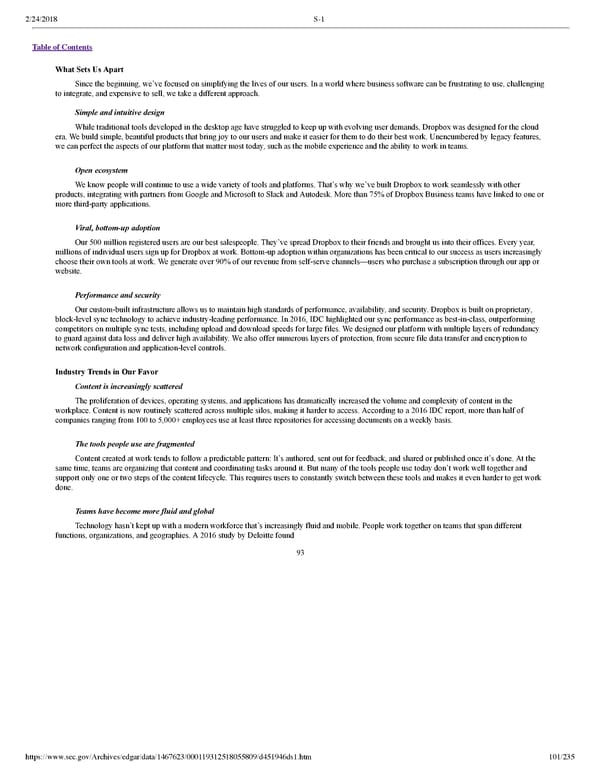2/24/2018 S-1 Table of Contents What Sets Us Apart Since the beginning, we’ve focused on simplifying the lives of our users. In a world where business software can be frustrating to use, challenging to integrate, and expensive to sell, we take a different approach. Simple and intuitive design While traditional tools developed in the desktop age have struggled to keep up with evolving user demands, Dropbox was designed for the cloud era. We build simple, beautiful products that bring joy to our users and make it easier for them to do their best work. Unencumbered by legacy features, we can perfect the aspects of our platform that matter most today, such as the mobile experience and the ability to work in teams. Open ecosystem We know people will continue to use a wide variety of tools and platforms. That’s why we’ve built Dropbox to work seamlessly with other products, integrating with partners from Google and Microsoft to Slack and Autodesk. More than 75% of Dropbox Business teams have linked to one or more thirdparty applications. Viral, bottomup adoption Our 500 million registered users are our best salespeople. They’ve spread Dropbox to their friends and brought us into their offices. Every year, millions of individual users sign up for Dropbox at work. Bottomup adoption within organizations has been critical to our success as users increasingly choose their own tools at work. We generate over 90% of our revenue from selfserve channels—users who purchase a subscription through our app or website. Performance and security Our custombuilt infrastructure allows us to maintain high standards of performance, availability, and security. Dropbox is built on proprietary, blocklevel sync technology to achieve industryleading performance. In 2016, IDC highlighted our sync performance as bestinclass, outperforming competitors on multiple sync tests, including upload and download speeds for large files. We designed our platform with multiple layers of redundancy to guard against data loss and deliver high availability. We also offer numerous layers of protection, from secure file data transfer and encryption to network configuration and applicationlevel controls. Industry Trends in Our Favor Content is increasingly scattered The proliferation of devices, operating systems, and applications has dramatically increased the volume and complexity of content in the workplace. Content is now routinely scattered across multiple silos, making it harder to access. According to a 2016 IDC report, more than half of companies ranging from 100 to 5,000+ employees use at least three repositories for accessing documents on a weekly basis. The tools people use are fragmented Content created at work tends to follow a predictable pattern: It’s authored, sent out for feedback, and shared or published once it’s done. At the same time, teams are organizing that content and coordinating tasks around it. But many of the tools people use today don’t work well together and support only one or two steps of the content lifecycle. This requires users to constantly switch between these tools and makes it even harder to get work done. Teams have become more fluid and global Technology hasn’t kept up with a modern workforce that’s increasingly fluid and mobile. People work together on teams that span different functions, organizations, and geographies. A 2016 study by Deloitte found 93 https://www.sec.gov/Archives/edgar/data/1467623/000119312518055809/d451946ds1.htm 101/235
 Dropbox S-1 | Interactive Prospectus Page 100 Page 102
Dropbox S-1 | Interactive Prospectus Page 100 Page 102